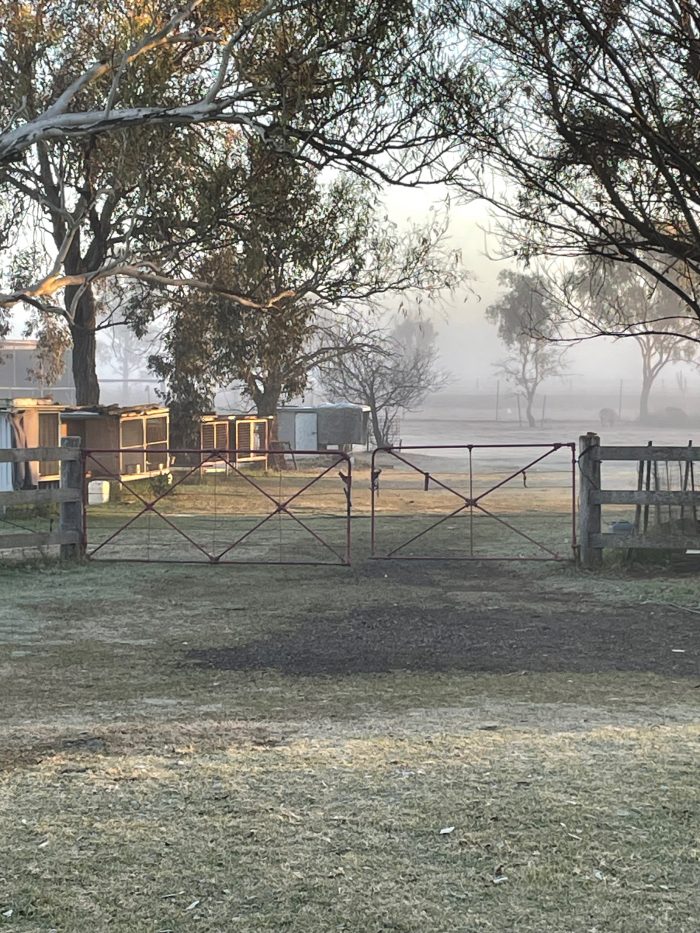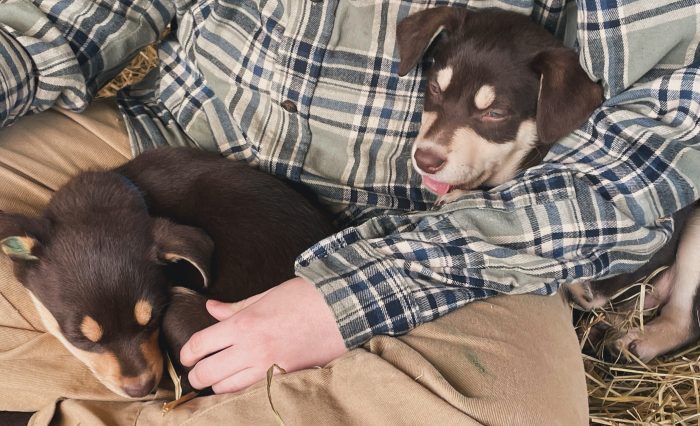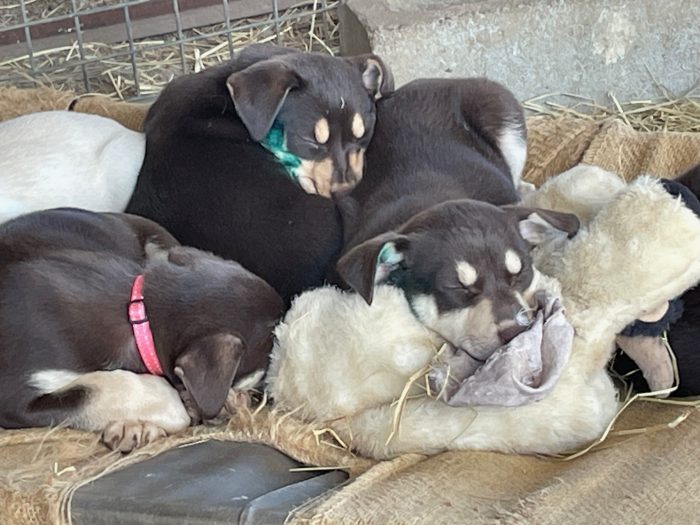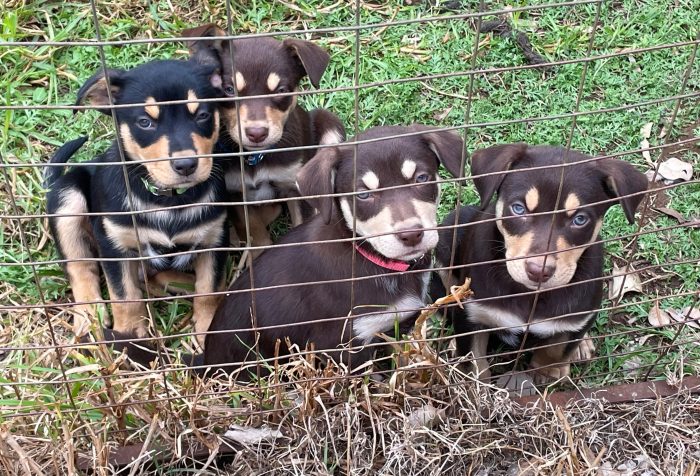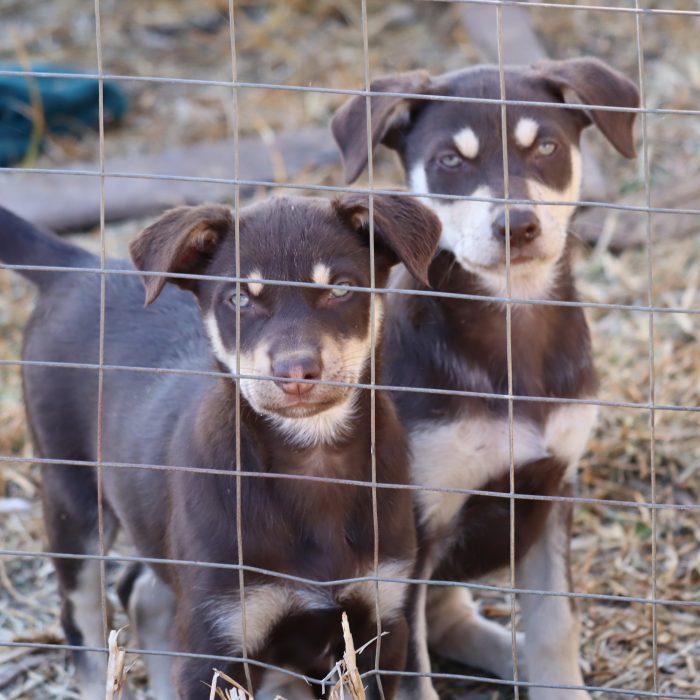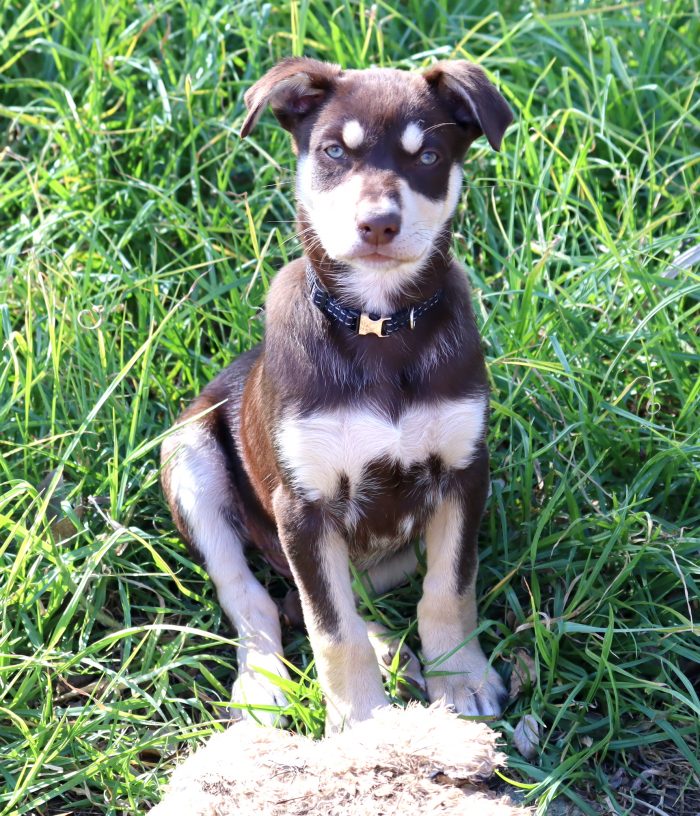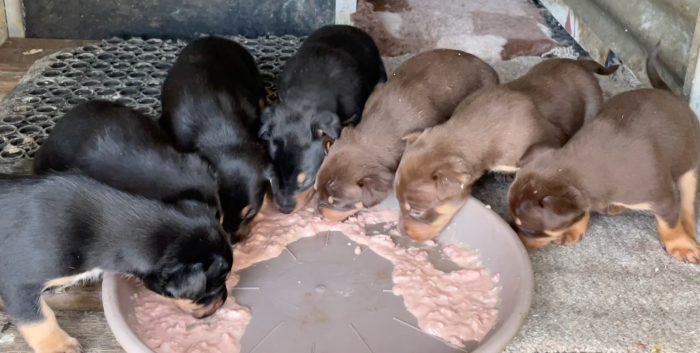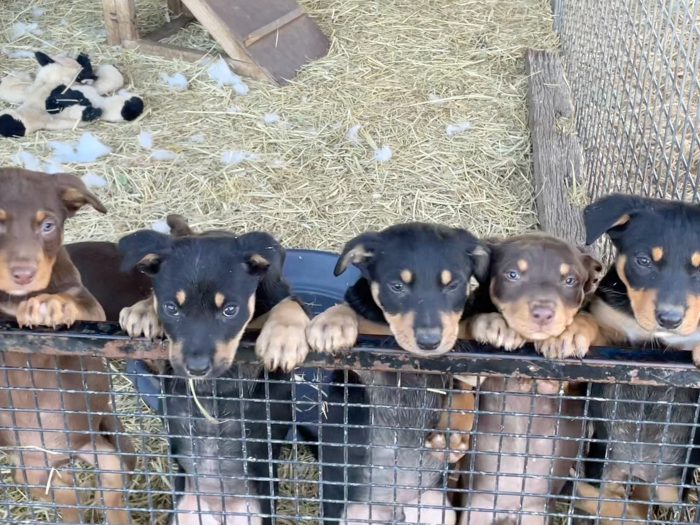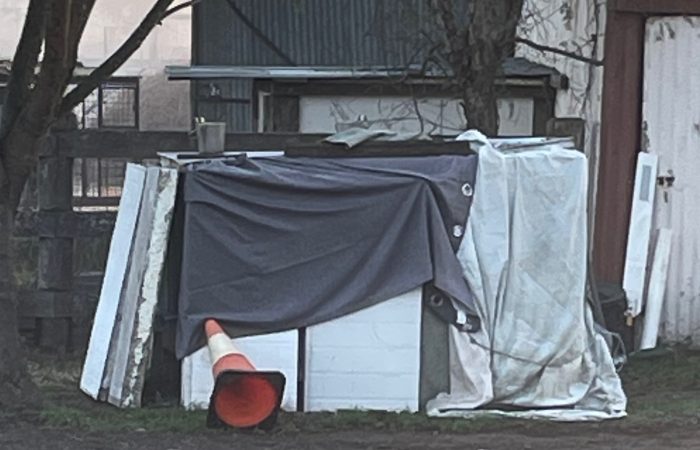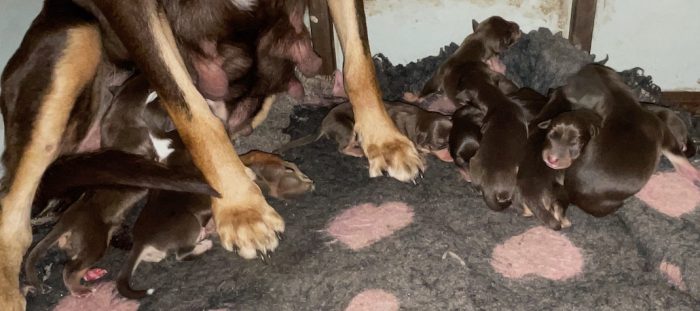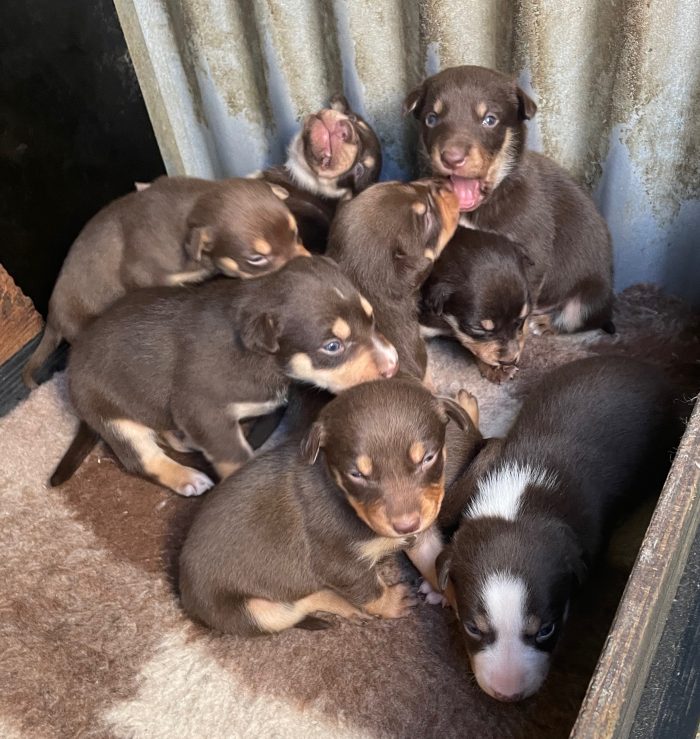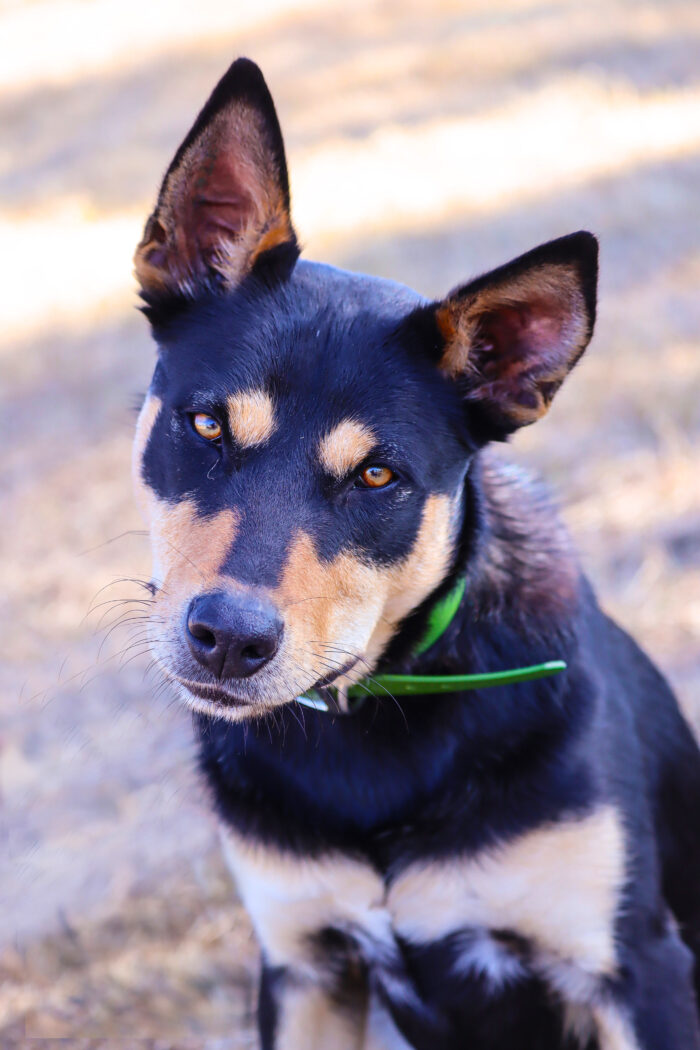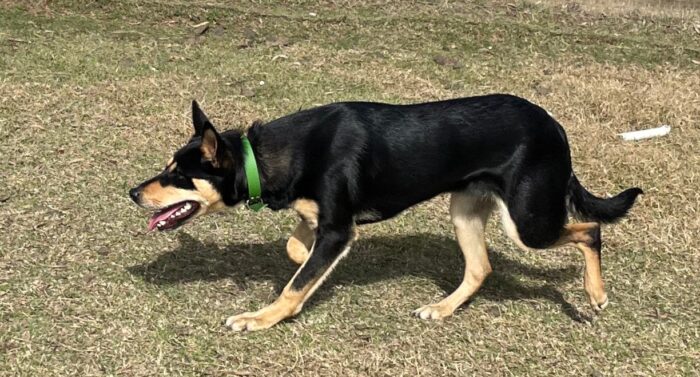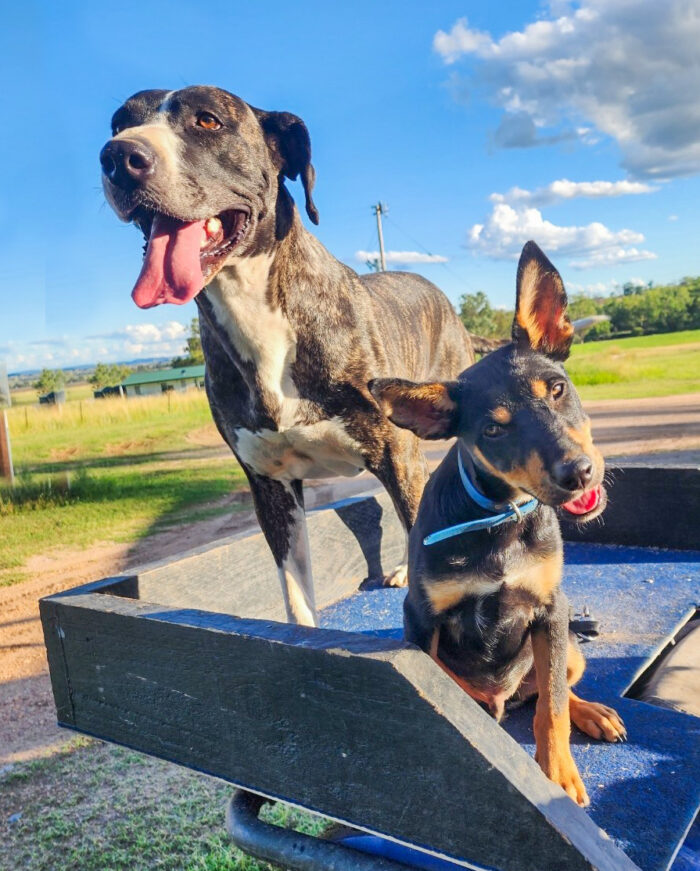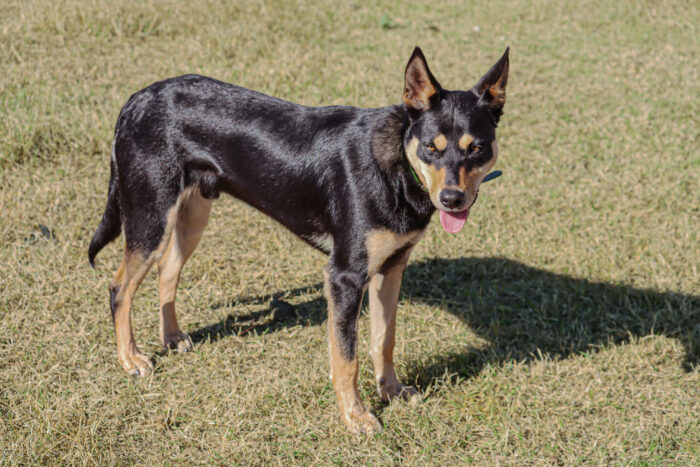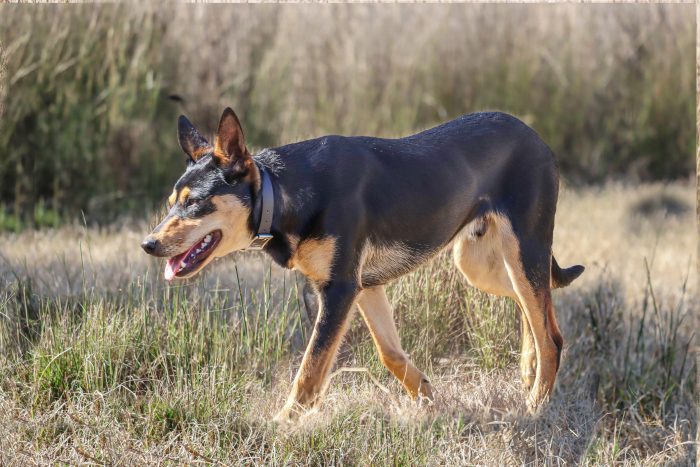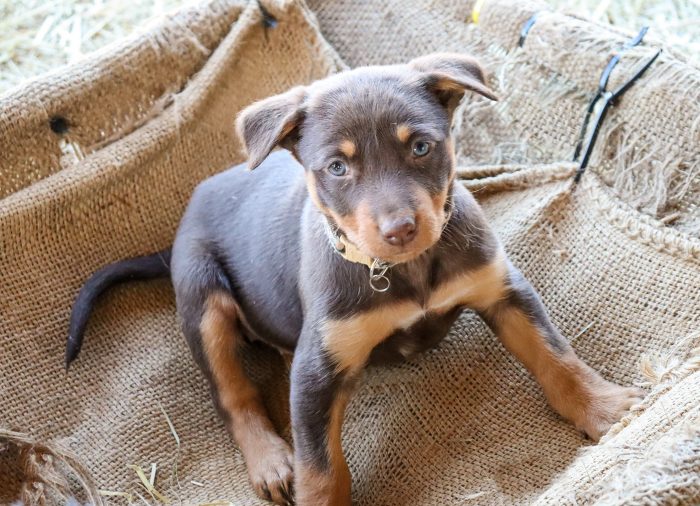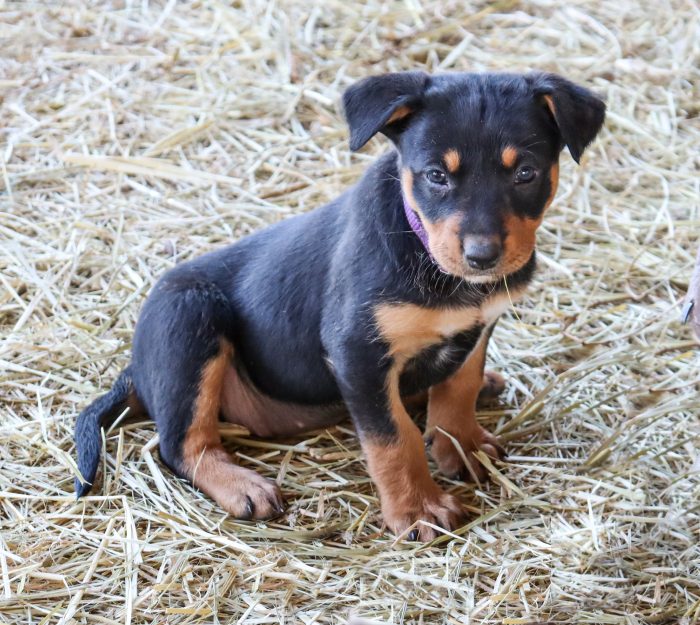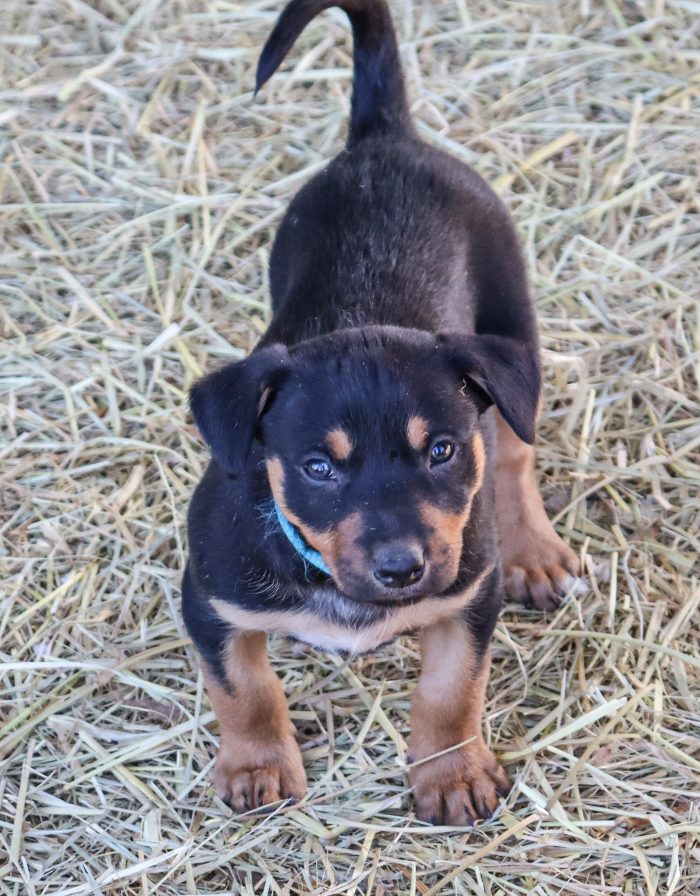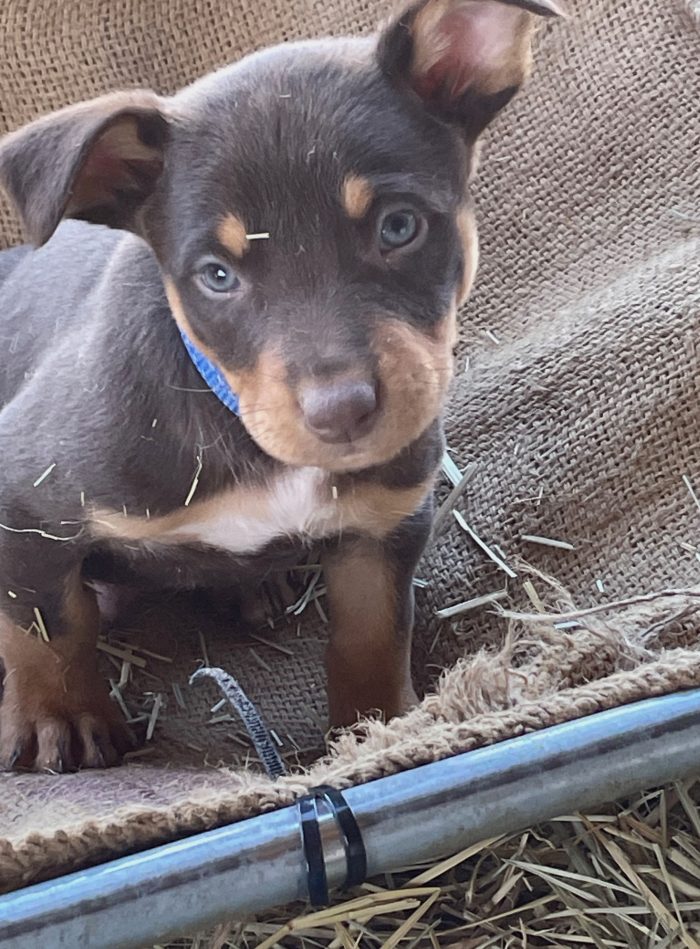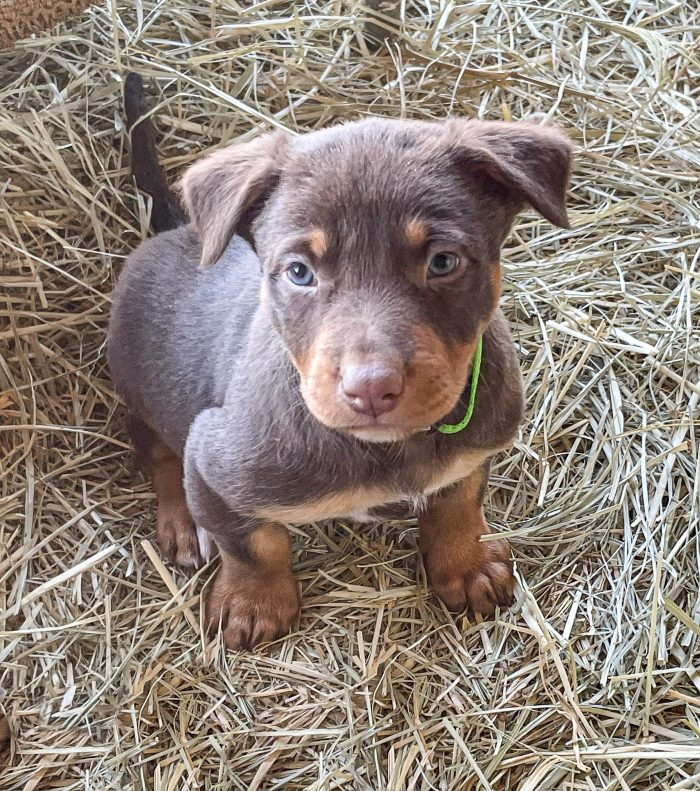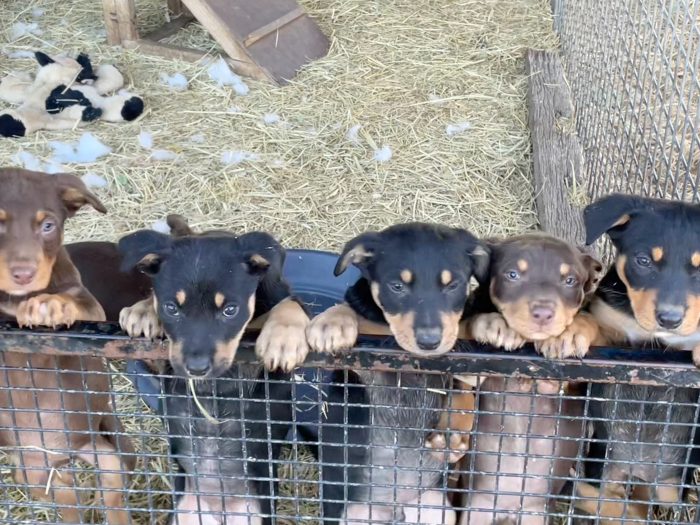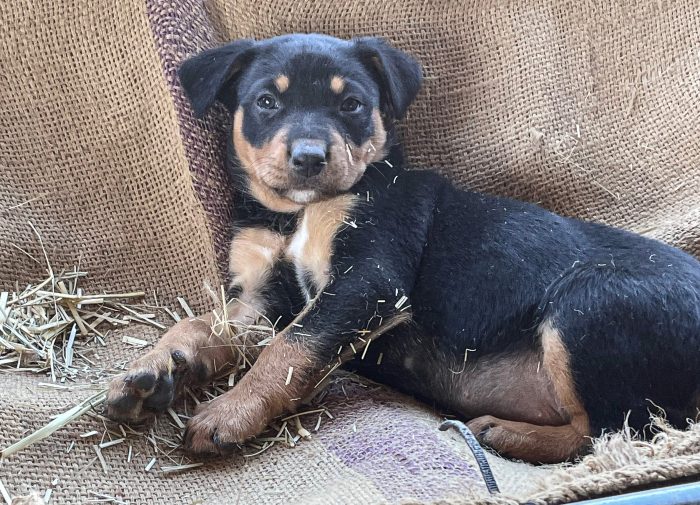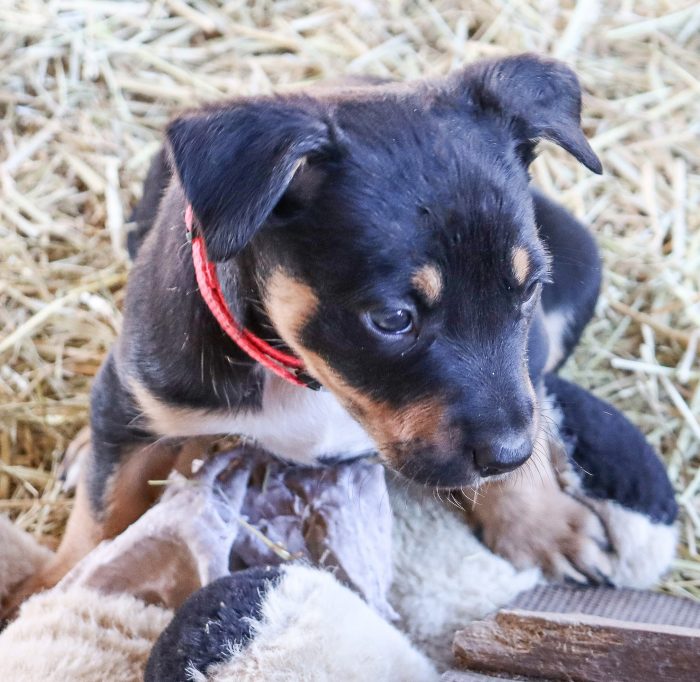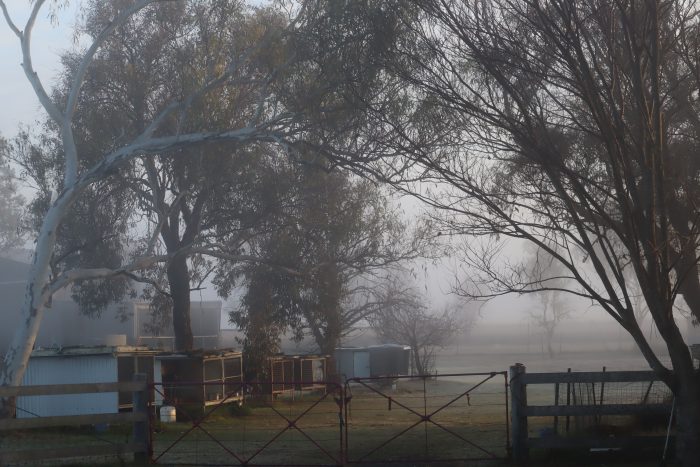August 2024
July certainly didn’t disappoint! Quite a few frosts, but worse than them…a week of freezing south/southwest gales! The first few days of August have been very Springy so hopefully the warmer weather will encourage the bitches to cycle.
We’ve been waiting for ages and there are none joined at present. Sass’s litter born mid July are the last ones born and all pups are sold at this stage.
It’s been nice to have some visitors from down south during July; the Livvy pups had lots of socialising and loved it!
They were also tattooed and coped very well. I’m always amazed at the growth they make in only 3-4 weeks between these monthly posts.
What a difference a month makes!
Meanwhile the Sid x Mina litter has been firing ahead about a week ahead of normal/usual development just like Mina’s previous litter, she’s certainly a super-mum! About 3 weeks between the photos below.
Sass struck very cold weather to whelp and I didn’t like putting her next to Mina in the big double whelping kennel as she’s a bit nervy when stressed. All would have gone well but she had nine pups and they were a bit small because of the number, she lost a little bitch leaving 3 girls and 5 boys.
I had a heater inside this igloo but it was hard to keep it warm with the awful winds!
The girls have remained smaller and are just starting on mince, they should be fine from now on. Sass tends to put more into fat than milk so has been on everything I can think of to get her to produce a bit more. Red meat rather than chicken, a little nettle root and fenugreek with an egg and some Ziwi Peak for lunch, lamb flap and bits of Big Dog’s you beaut new “Wild Harvest” rolls for tea. Lucky there was a 20% off introductory offer!
Sass produced a strong little boy who has thrown back to Collie blood introduced about 60 years ago! We weren’t surprised because Glenville Swannee and Glenville Prince appeared so many times in the Homoz. table due to Shanahan’s Loo being used liberally for her great cast. 
It was timely that there was an article printed in the July WKC Bulletin that referred to the over use of famous sires(/dams) which I’ll try and copy here. It’s a good read and very timely with a number of popular yard dogs appearing frequently in pedigrees.
| The Price of Popularity: Popular Sires and Population Genetics |
C.A. Sharp
Consider the hypothetical case of Old Blue, Malthound extraordinaire. Blue was perfect: Sound, healthy and smart. On week days he retrieved malt balls from dawn to dusk. On weekends he sparkled in malt field and obedience trials as well as conformation shows, where he baited to–you guessed it–malt balls.
Everybody had a good reason to breed to Blue, so everybody did. His descendants trotted in his paw-prints on down through their generations. Blue died full of years and full of honor. But what people didn’t know was that Old Blue, good as he was, carried a few bad genes. They didn’t affect him, nor the vast majority of his immediate descendants. To complicate the matter further, some of those bad genes were linked to genes for important Malthound traits.
A few Malthounds with problems started showing up. They seemed isolated, so everyone assumed it was “just one of those things.” A few declared them “no big deal.” Those individuals usually had affected dogs. All in all, folks carried on as usual.
Time passed. More problem dogs turned up. People made a point not to mention the problems to others because everyone knows the stud owner always blames the bitch for the bad tings and takes credit for the good. Stud owners knew it best to keep quiet so as not to borrow trouble. Overall, nobody did anything to get to the bottom of the problems, because if they were really significant, everybody would be talking about it, right?
Years passed. Old Blue had long since moldered in his grave. By now, everyone was having problems, from big ones like cataracts, epilepsy or thyroid disease to less specific things like poor-keepers, lack of mothering ability and short life-span. “Where can I go to get away from this?” breeders wondered. The answer was nowhere.
People became angry. “The responsible parties should be punished!” Breeders who felt their programs might be implicated stonewalled. Some quietly decided to shoot, shovel and shut-up. A few brave souls stood up and admitted their dogs had a problem and were hounded out of the breed.
The war raged on, with owners, breeders and rescue workers flinging accusations at each other. Meanwhile everybody carried on as always. After another decade or two the entire Malthound breed collapsed under the weight of its accumulated genetic debris and went extinct.
This drastic little fable is an exaggeration–but not much of one. Here’s similar, though less drastic, example from real life: There once was a Quarter Horse stallion named Impressive. The name fit. He sired many foals who also exhibited his desired traits. But when they and their descendants were bred to each other, those offspring sometimes died. Impressive had been the carrier of a lethal single-gene recessive trait. No one knew it was there until they started in-breeding on him. The situation of a single sire having this kind of drastic genetic effect on a breed became known as the “Impressive Syndrome.”
Many species and breeds of domestic animals, including dogs, have suffered “Impressive Syndromes” of their own. But cases like that of Impressive are only the tip of the iceberg. A single-gene recessive becomes obvious in just a few generations. But what about more complex traits?
This is not to say that those popular sires we so admire are bad breeding prospects. Their many excellent traits should be utilized, but even the best of them has genes for negative traits.
The problem is not the popular sires, but how we use them. For a century or more, in-breeding has been the name of the game. (For the purposes of this article, “in-breeding” refers to the breeding of dogs related to each other and therefore includes line-breeding.) By breeding related individuals, a breeder increased his odds of producing dogs homozygous for the traits he wanted. Homozygous individuals are much more likely to produce those traits in the next generation.
When a male exhibits a number of positive traits and then proves his ability to produce those traits he may become a popular sire, one that is used by almost everyone breeding during his lifetime, and maybe beyond, thanks to frozen semen.
Since the offspring and grand-offspring and so on are good, breeders start breeding them to each other. If the results continue to be good, additional back-crosses may be made for generations. Sometimes a sire will be so heavily used that, decades hence, breeders may not even be aware of how closely bred their animals are because the dog no longer appears on their pedigrees.
This is the case in Australian Shepherds. Most show-line Aussies trace back, repeatedly, to one or both of two full brothers: Wildhagen’s Dutchman of Flintridge and Fieldmaster of Flintridge. These, products of a program of inbreeding, were quality individuals and top-producing sires. They are largely responsible for the over-all quality and uniformity we see in the breed ring today–a uniformity that did not exist before their birth nearly three decades ago.
Working lines have also seen prominent sires, but performance traits are far more complex, genetically and because of the significant impact of environment. They are therefore harder to fix. Performance breeders will in-breed, but are more likely to stress behavioral traits and general soundness than pedigree and conformational minutiae. The best working sires rarely become as ubiquitous as the best show-line sires.
Not every popular sire becomes so because of his ability to produce quality offspring. Some have won major events or are owned by individuals with a knack for promotion. Such dogs may prove to be wash-outs once their get is old enough to evaluate. But a lot of breeders have been using the animal for the few years it takes to figure that out, the damage may already have been done.
Use of even the best popular sires, by its very nature, limits the frequency of some genes in the breed gene pool while simultaneously increasing the frequency of others. Since sons and grandsons of popular sires tend to become popular sires the trend continues, resulting in further decrease and even extinction of some genes while others become homozygous throughout the breed. Some of these traits will be positive, but not all of them.
The owners of Old Blue, the Malthound in the opening fable, and those who owned his most immediate descendants had no idea what was happening under their noses. They were delighted to have superior studs and even more delighted to breed them to as many good bitches as possible.
Dog breeding and promoting is an expensive proposition. One usually winds up in the hole. But owning a popular sire can change that. The situation looks like a winner for everyone–the stud owner finds his financial burden reduced while breeders far and wide get to partake of his dog’s golden genes.
No one breeding dogs wants to produce sick dogs. A small minority are callous and short-sighted enough to shrug genetic problems off as the price you pay to get winners, but even they do their best to avoid letting it come to general attention.
We need a total re-thinking of how we utilize stud animals. No single dog, no matter how superior, should dominate the gene pool of its breed. Owners of such sires should give serious consideration to limiting how often that dog is used, annually, through its lifetime and on into the future, if frozen semen is stored. The stud owner should also look not only at the quality of the bitches being presented, but their pedigrees. How much will the level of inbreeding be increased by a particular mating?
The bitch owner also needs to think twice about popular sires. If you breed to the stud of the moment and everyone else is doing the same, where will you go when it comes time to make an outcross?
Finally, the attitude toward genetic disease itself has to change. It must cease being everyone’s dirty little secret. It must cease being a brick with which we bludgeon those with the honesty to admit it happened to them. It must become a topic of open, reasoned discussion so owner of stud and bitch alike can make informed breeding decisions. Unless breeders and owners re-think their long-term goals and how they react to hereditary problems, the situation will only get worse.
C.A. Sharp is editor of the “Double Helix Network News”. This article appeared in Vol. IV, No. 3 (Summer 1998). It may be reprinted providing it is not altered and appropriate credit is given.
Coincidentally, this is how CA spread in Working Kelpies until it was pretty much everywhere except for a few studs who were aware of the dogs spreading it. Fortunately we now have a test and can breed around it… and hopefully such a ‘fault’ won’t be covered up again.
I have some older pups here who would be normally getting tried on cattle, but due to Em having an accident they’re having a nice long holiday with me. They’re unlikely to forget how to work because the sheep come up at night and wander around the kennels annoying them. Hackett is for sale because I have two other litter mates. He’s a very nice young dog, hopefully the right person will come along; I never try to push a sale, Karma usually sorts them out if I’m patient!
More photos and video on the Pups for Sale page.
Karmala Hackett( Karmala Vlad/Barney x Karmala MinaWylie) Hackett 19 june short vid.
Sam who has Thorpe, Hackett’s brother, saw he was for sale and rang this week to say how happy he is with him. Remember the photo of him with Sam’s pig dog?
This is Perkins, the brother I’m keeping for now. A nice relaxed young dog, very natural worker.
Finally some cute photos of Mina’s little Olympic swimming team, I hope they live up their illustrious namesakes!! Mollie, Kaylee, Ariane, Emma, Kyle, Elijah and Cam!
Arie
